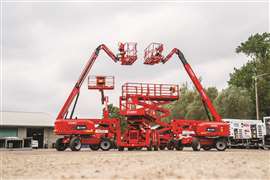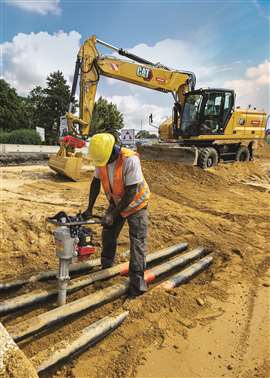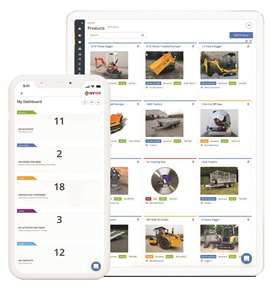Setting the right rates: pros and cons of dynamic pricing in rental
21 January 2025
The benefits of dynamic pricing can go far beyond optimising revenues, offering rental companies smarter fleet utilisation, increased flexibility and a competitive edge.
 Storent says it undertakes ongoing data analysis on a number of factors, tailored to the specifics of individual markets. Photo: Storent
Storent says it undertakes ongoing data analysis on a number of factors, tailored to the specifics of individual markets. Photo: Storent
The reunion of British indie group Oasis certainly created a stir when it was announced in August, with tickets selling out minutes after going on sale.
However, the sales process was largely criticised by the general public due to ticket vendor TicketMaster’s use of dynamic pricing, which saw some fans pay more than double the original price.
For many, it was their first experience of dynamic pricing, a flexible pricing strategy where prices are adjusted in real time or periodically based on various factors such as supply, demand, competition, time or customer behaviour.
And, while the advice to fans impacted by a pricing format they seemingly knew little about could have been “Don’t Look Back in Anger”, the process called into question the benefits of adopting such a format.
It is of course more prevalent in other industries (see the hotel and aviation industries for reference), and you can put the equipment rental sector into that category, with a number of companies adopting it.
For those companies, setting profitable rental rates is perhaps the most important variable central to success. Do it right, and you’re golden. Do it wrong, however, and well, nothing else you do matters very much.
For example, a rental company might lower its rates for wheel loaders if that fleet is seeing consistently low utilisation.
Likewise, rates for lawn maintenance equipment might drop in the cooler months, due to seasonality. It works the other way too. Rates could go up during peak season to capture more value from machines that are in high demand.
The pros and cons of dynamic pricing
While rental rates have never been strictly “fixed,” they’ve always fluctuated due to various factors, but they still fall under the umbrella of a fixed pricing strategy. In other words, the frequency and number of variables are lower than with dynamic pricing.
Fixed pricing allows rental businesses to avoid the risks and costs of frequent price changes. For example, a business might set the prices of their products based on their costs, margins and value proposition, and maintain them throughout the year, or only change them occasionally for promotional purposes.
With dynamic pricing, price changes are much more fluid. Take for example the format from Storent Group which has adopted it since being founded to ensure company growth and steady gain of market share.
The company says it undertakes data analysis on a number of factors, tailored to the specifics of individual markets, into account, including fleet availability, seasonal impact and demand, product group utilisation and payback, and development strategy for a product group and its application to pricing.
The company also monitors what others in the industry are doing, as well as following major changes, market situations and “carefully evaluating upcoming business pipelines.”
In fact, it attributes recent growth to the format, adding that it has seen measurable impact of dynamic pricing on business profitability which has “allowed us to penetrate not so obvious market segments and to become attractive to all customer importance groups.”
Zeppelin Rental, too, has seen a measurable increase in profitability and fleet utilisation since adopting dynamic pricing, a system which it describes as a “no one-fits-all solution but target-orientated pricing.”
 Zeppelin has seen a measurable increase in profitability and fleet utilisation since adopting dynamic pricing. Photo: Zeppelin Rental
Zeppelin has seen a measurable increase in profitability and fleet utilisation since adopting dynamic pricing. Photo: Zeppelin Rental
Key to the success, the company says, is sales communication; “In our private lives, we are constantly confronted with dynamic pricing (train bookings, holiday trips, Amazon, petrol stations, etc.). Transparency must be given to the customer, and it must also be explained how the price is calculated.”
Customer feedback
Meanwhile, Storent says that despite bad press, customers are receptive to the different pricing model.
Firstly, it says as customers are becoming more demanding and want to understand the influence of their business size (orders volume and frequency), rental term duration, rented equipment volume and seasonal impact on the pricing, the way its invoice and online cabinet is designed “allows customers to see relation of mentioned factors.”
Secondly, they are ready to commit to longer rental periods when they see it makes overall price more attractive.
“We have also noticed that Covid restrictions shaped customers online shopping habits and drove growth of our online orders,” the company says.
However, it does note that in some countries, customers try to get the lowest rental price for the shortest rental period, even during the highest (demand) period of the year.
Elsewhere, Dennis Helderman, co-founder and CEO of easyHire, says the company is seeing an increase in customers looking for digital solutions that address key pain points, including pricing optimisation.
The company is using dynamic pricing in the form of its own Smart Pricing platform for its partnership with UK retailers Wilko and The Range to offer a “value-driven approach for rental services.”
He says that by adjusting prices on several factors, easyHire can ensure customers receive competitive, real-time rates that reflect market conditions.
“Dynamic pricing is a widely adopted strategy in many industries, yet the equipment rental sector is still in the early stages of embracing it,” he says. “At easyHire, we’re actively bridging this gap, bringing a proven, flexible pricing model to an industry ready for modernisation.
“Our Smart Pricing platform – powered by AI – adjusts rates dynamically, allowing rental companies to optimise utilisation, reduce idle time and maximise revenue during peak demand.”
He adds that although skip/tool/plant hire has been historically manual, the introduction of dynamic pricing is enabling rental companies to better manage resources during peak periods and improve profitability and availability at the same time.
Tech or human?
While dynamic pricing typically utilises technology, Storent takes what it describes as a hybrid approach.
Some prices are calculated by algorithms, while the human element is a factor in others that needs sales teams to apply other factors not visible to the system to ensure the most attractive pricing.
HSS: The Hire Service Company in the UK has adopted a similar model which sees humans at the heart of the process, as Nick Hadley, branch director, explains, “Whilst our operating system runs on a sophisticated tech platform, we empower our local teams to tailor prices themselves – based on their knowledge of their customers, our products and the local market.
“We have a list price for every piece of kit we hire, but our teams can vary that price – within guideline parameters – depending on things like the volume and length of hire, and the seasonal popularity of the products.
 inspHire says dynamic pricing can do the “heavy lifting involved in finance, operations, logistics, asset management”. Photo: inspHire
inspHire says dynamic pricing can do the “heavy lifting involved in finance, operations, logistics, asset management”. Photo: inspHire
“It’s ‘dynamic pricing’ but using an old-school human interface that ensures a dose of good old fashioned common sense is applied alongside friendly customer service rather than just an impersonal automated algorithm.
“When teams are trusted to trade, dynamic pricing can be done by humans just as well as by tech – perhaps even better as we deliver it with a smile too!”
Is dynamic pricing fair for customers?
The Oasis controversy also brought up the question as to fairness to customers. However, Storent points out that the highly competitive market of the rental industry means rental companies remain fair in pricing, as there is “no monopoly in this industry.”
Rental customers are protected from having to pay high rates as they can often go elsewhere for less.
In fact, Storent tells IRN that it wouldn’t benefit from high prices, instead it highlights the fleet management benefits; “To maximise revenue, we must constantly analyse a wide range of factors. For us one of the key winning factors is effective management of the fleet. We maximise rental revenue via effective use of the fleet and strategic investments.”
Meanwhile, Zeppelin Rental says its pricing team is constantly monitoring and controlling the systems pricing to ensure it remains fair for customers, while it has also set a clear definition of rules to prevent various distortions in pricing.
It says that despite offering a different payment method, it hasn’t noticed changes to customer behavior as “customers get used to changes very quickly if you explain them well and transparently.”
Meanwhile, although he admits that it is still in the early stages of adoption, Helderman says the company believes that the future of equipment rental is personalised service such as dynamic pricing that is powered by Artificial Intelligence (AI), which he describes as a “seamless digital journey that enhances, not replaces, the human touch.”
He says the level of automation offers rental companies a “sophisticated tool to stay competitive without needing extensive manual intervention.”
Meet the suppliers
While some companies develop their own systems, others opt to outsource to software specialists. One of those specialists is Wynne Systems, which, through its RentalMan platform, offers several pricing models.
In the case of its dynamic pricing feature, the company uses pricing data uploads from rental data specialist Rouse, that take place in periodic updates between Rouse and RentalMan.
The timing of the periodic updates is customisable for each rental company and RentalMan users can also choose how often the updates happen. Prices can also be manually overridden by users if they have the right security requirements.
 Wynne recently updated its RentalMan offering. Photo: Wynne Systems
Wynne recently updated its RentalMan offering. Photo: Wynne Systems
The company tells IRN, “One of the things that makes RentalMan unique is its ability to flex and adapt to all the different changes that can happen throughout a rental contract.
“Equipment swaps, field service, and more can all be accounted for without needing to start new contracts and subsequent billing.”
Like Wynne and Zeppelin, rental software provider inspHire also believes that there is no “one size fits all” method of taking care of business.
The company’s rental management solutions typically focus on a series of rental rate types that can be configured based on a global, regional, depot, product, customer or project level.
Mark Taylor, director of product management, Kerridge Commercial Systems (Rental), tells IRN, “It all depends on the company size, geographic location, the type of equipment rented out – the more combinations of this a rental company have, the more complex pricing can become. There are numerous ways rental companies have designed their pricing algorithms to remain competitive.”
One of the key features of inspHire, he says, is its ability to forecast equipment demand based on various scenarios, including whether items are due for collection and will be available in the future, or if incoming purchase orders are scheduled for delivery.
It also incorporates budgeting screens to determine what should be purchased and moved to satisfy future projects based on anticipated demand. The company says this model increases utilisation and ROI for rental companies, ensuring the right equipment is in the right place, at the right time, at the right price.
And, if external systems are used, Taylor says they can handle the “heavy lifting involved in finance, operations, logistics, asset management for all types of rental lifecycles.”
STAY CONNECTED



Receive the information you need when you need it through our world-leading magazines, newsletters and daily briefings.
CONNECT WITH THE TEAM







